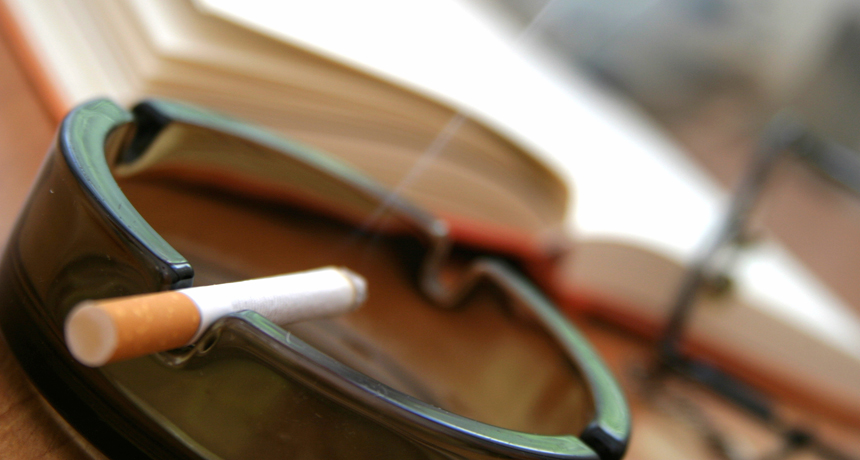Thirdhand smoke poses lingering danger
Harmful cigarette chemicals that linger on surfaces can go on to pollute the air

HAZARDOUS PLUME The toxic compounds from cigarette smoke can land on surfaces and then produce gases and particles that pose health risks.
Krzysiek_z_poczty/iStockphoto
The stench of past cigarettes may be as toxic as a breath of fresh smoke.
That loitering odor, called thirdhand smoke, may cause up to 60 percent of the harm caused by routine exposure to smoke, including a year or so of life lost, scientists report in a paper to be published in Environmental Science & Technology.
Thirdhand smoke’s vestigial funk comes from inhalable particles and fumes that off-gas from the chemical debris that settles out from burned cigarettes and secondhand smoke. In laboratory experiments and air samples from a smoker’s home, researchers find that the wafting pollutants, some at dangerously high levels, can haunt an indoor space for as long as 18 hours after smoking.
“This is enormously important,” says pediatrician Jonathan Winickoff of Massachusetts General Hospital in Boston. “It reinforces the notion that it’s not safe to smoke in any indoor or closed environment.”
Researchers had previously noted some dangers of thirdhand smoke indoors. Chemicals from smoke that settle into furniture, flooring and even walls can themselves be hazardous and can also react with common indoor chemicals to form carcinogens. Cigarettes’ waste and its cancer-causing by-products can lie in wait to be inadvertently touched or ingested, such as by toddlers with a tendency to mouth furniture. But little was known about the inhalable components of thirdhand smoke.
To identify vented pollutants, chemist Hugo Destaillats of the Lawrence Berkeley National Laboratory in California and colleagues monitored air in a room-sized chamber —18 cubic meters —after six cigarettes were smoked in it. The researchers measured amounts of floating particles and tested the levels of 58 volatile organic compounds at various times between 20 minutes and 18 hours after smoking. The time points allowed the researchers to track the transition from secondhand to thirdhand smoke.
Though the bulk of the particles and gases dropped out of the air after 20 minutes, some lingered, new chemicals emerged and some compounds hit dangerously high concentrations. Levels of acetonitrile, a poisonous organic compound, and 2-butanone, an irritant, rose after two hours and remained in the air for the full 18 hours. Destaillats and colleagues found that the acetonitrile level was so consistently high after two hours that it could be used as a chemical fingerprint for thirdhand smoke.
The researchers found that three components of thirdhand smoke hit levels above the harmful dose limits set by state environmental agencies: acrolein and methacrolein, both respiratory and eye irritants, plus acrylonitrile, a highly flammable, toxic compound linked to cancer.
For a reality check, the researchers sampled the air in a smoker’s home at the same time points after smoking. The team found similar chemical signatures of thirdhand smoke, backing up the laboratory findings.
“These compounds are quite reactive and they’re quite dangerous,” says chemist Lara Gundel, a researcher also at the Berkeley lab. “And they’re not mentioned very often in secondhand smoke.”
Using health-impact data from previous research, the researchers calculated that over 50 years, a nonsmoker living with someone who smokes 28 cigarettes a day —a common amount —would probably lose about a year of life and potentially up to seven years due to a combination of secondhand and thirdhand smoke. Up to 60 percent of that loss of life could be due solely to thirdhand smoke, the researchers found.
The authors did an excellent job simulating the health effects, says psychologist Georg Matt, who studies tobacco use at San Diego State University in California. The research is “a very important chapter on the long-term toxic legacy of tobacco smoke in indoor environments,” he adds.
Destaillats notes that these estimates are still uncertain and vary with a home’s ventilation. Also, researchers might debate where to draw the line between secondhand and thirdhand smoke. In reality, it’s a continuum of exposure, he says.
Despite the uncertainty, the findings may capture only a minimum of the health effects from thirdhand smoke. Matt and the authors point out that the new paper’s analysis doesn’t include the chemicals that have settled out of the air. “Deposited compounds continue to undergo chemical reactions for weeks, months and perhaps years,” Matt says.







